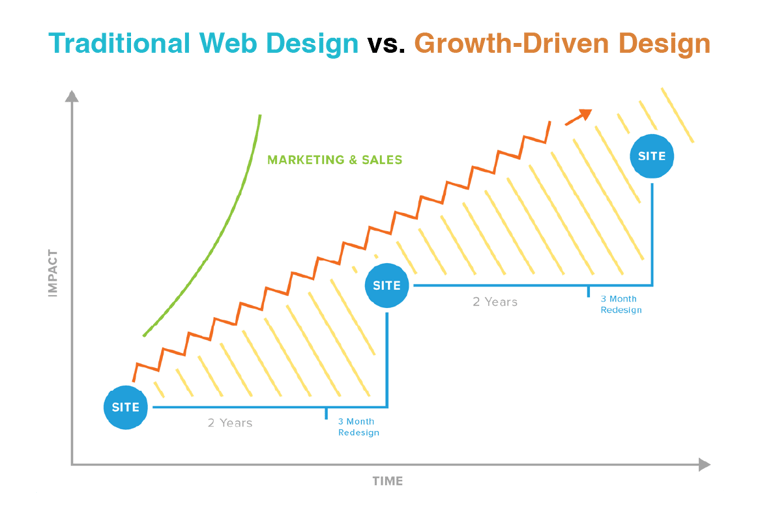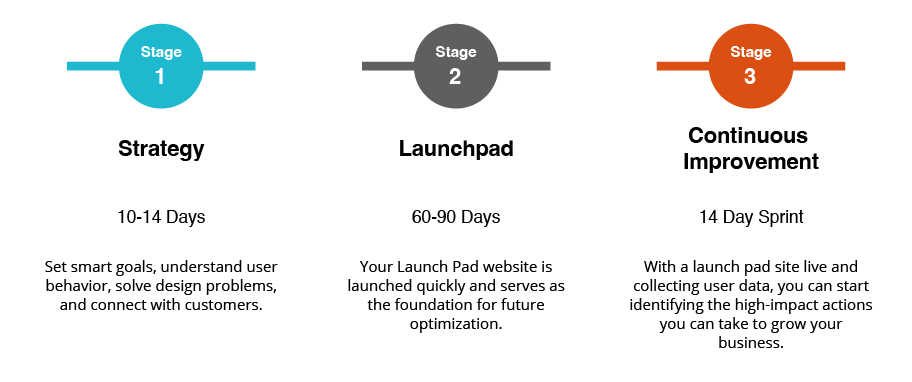| Growth-Driven Design is an iterative methodology for continuously improving websites through user feedback. |
‘Growth-driven design’ is a method of constructing and optimising websites that prioritises user feedback and data as the primary drivers in design decisions. It's a reliable way of continuously improving your website, providing users with meaningful experiences that can lead to deeper engagement or further actions.
Growth-driven design in a digital world
In today's fast-evolving digital world, having a website that can attract traffic, generate leads and increase revenue is essential for all businesses. The issue that most businesses face is that their websites are not built with these three goals in mind; some businesses are unaware of this, while others may struggle with implementing these goals into their websites.
This is where Growth-Driven Design (GDD) comes in. It offers a more flexible, agile, and cost-effective approach to website design, resulting in a website that evolves over time and consistently performs better.
In this article, we'll compare two methodologies of building websites, namely the traditional way and Growth-Driven Design. We’ll also highlight the stages of GDD and show you how it can help you build a high-converting website that drives growth for your business.
Traditional vs Growth-Driven Design
Traditional web design involves designing a website linearly, from planning and designing to development and launch. This process can take several months, often close to a year, and requires a significant upfront investment. The biggest issue with traditional website design is that once the website is launched, it can quickly become outdated as it is built on outdated assumptions and information, almost ensuring that it fails to meet the evolving needs of users and the business.
Growth-driven design, on the other hand, takes a different approach. It takes an iterative process that focuses on continuous improvement and data-driven decision making. Instead of creating a complete website upfront, GDD involves producing a "launch pad" website firstly, with only the essential features which will be improved upon over time.
One of the greatest advantages of GDD is that it allows a website to be launched quickly with less investment than a traditionally built one. This means the website can start driving traffic and collecting data almost immediately. Additionally, GDD allows for continual improvements through user behaviour data and feedback, ensuring that it stays relevant and effective over time.

Key differences between traditional web design and GDD include:
Timeframe: Traditional web design can take several months or even years, while GDD involves delivering a "launch pad" website in 60-90 days.
Upfront investment: Traditional web design requires a large upfront investment, while GDD allows you to start with a smaller investment and build on it over time.
Data-driven decision-making: GDD prioritises decisions based on data retrieved and allows continuous improvement, while traditional web design is more static and inflexible.
By understanding the differences between traditional web design and GDD, you can choose the approach that best suits your business needs and goals.
|
Traditional Web Design |
Growth Driven Design |
|
- Huge time investment |
+ Fast launch and continuous optimisation |
|
- Large upfront cost |
+ Investment spread over time |
|
- Often runs late and over budget |
+ Launches on time and within budget |
| - Built on potentially outdated information |
+ Data-driven decisions |
|
- Set it and forget it |
+ Month-by-month improvements |
The 3 stages of Growth-Driven Design
The GDD process is divided into three phases: strategy, launchpad, and continuous improvement.
1. Strategy: The strategy phase focuses on understanding the target audience and creating a user-focused design. This involves identifying the buyer personas, mapping out the customer journey, and defining the website goals and metrics. The aim is to create a website that’s tailored to the target audience’s needs and also drives business growth.
2. Launchpad: The launchpad phase involves building and launching a website within two to three months after the strategy phase. The aim is to create a functional, user-friendly website that provides a positive user experience.
3. Continuous Improvement: The continuous improvement phase involves using data and feedback to optimise the website further. This is done through a process of testing, learning, and refining.

The primary focus of growth-driven design is to launch a minimum viable website and then quickly learn so that the insights gained can be used to enhance the website further. This method isn't just limited to new websites; existing sites can also be improved using this approach. Knowing how growth-driven design works can help websites become successful for their users and businesses alike.
Unlike traditional web design, which relies on guesswork and outdated information, growth-driven design uses live data and real-world user feedback to drive decision-making, resulting in websites that are more effective and efficient and better able to meet the needs of their users.
If you're looking to get the most out of your website, growth-driven design is a definite consideration you’d probably like to make.
Is Growth-Driven Design right for your business?
Although growth-driven design ensures that your website is continually optimised and up-to-date, it may not be the right approach for every business; context is essential. GDD requires a mindset shift and a willingness to embrace change and experimentation. It also requires ongoing investment in website development and maintenance, which may not be feasible for all businesses.
Before deciding whether to implement GDD, it’s important to consider your business goals, budget, and available resources. If you need support in the shape of our expert advice on website development, and whether GDD would suit your needs, feel free to get in touch.
The GDD methodology may be particularly beneficial for businesses that rely heavily on their website for lead generation and customer acquisition, as it can help drive more traffic, leads, and sales with a faster lead time.
Overall, growth-driven design offers a more effective and efficient approach to website development that can help businesses to stay competitive in today's digital landscape.

